By Lyra Fontaine
ME students, alums and faculty share how clubs can lead to successful careers.
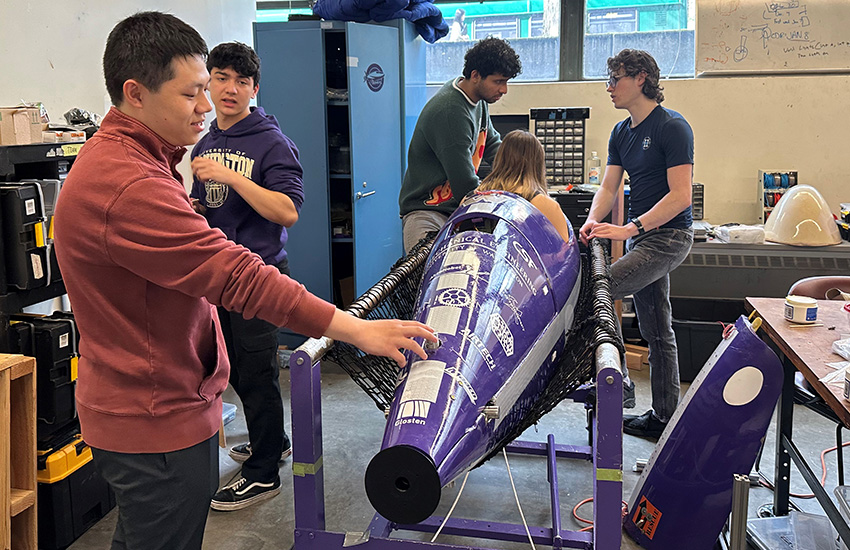
The UWPHS team, which designs and manufactures a submarine to compete in international competitions, works on their 2024 submarine. Photo by Lyra Fontaine
For many ME students, participating in a student club can be life-changing. Whether they build robots, vehicles and submarines or create solutions to accessibility challenges, students form lasting connections and develop hands-on skills that set them up for success in their careers.
As a member of HuskyADAPT, a student organization focused on supporting accessible design and inclusive play technology, Tom Mikolyuk (B.S. ’23) learned to create products that center users’ needs. He’s now a product development engineer at Chiplytics, which develops data-driven inspection technology for microelectronics.
The engineers who are able to understand not just what they’re making and how to make it, but why and who they’re making it for, are making the biggest impacts on their project, company and industry.”
“I’ve been able to provide more value to the company and grow exponentially as an engineer because my UW experience focused on equal parts technical skills and people skills,” Mikolyuk says. “The engineers who are able to understand not just what they’re making and how to make it, but why and who they’re making it for, are making the biggest impacts on their project, company and industry.”
Participating in clubs also enhances ME students’ experiences as they build community, network with alumni and celebrate their accomplishments.
“The pride of having worked together to do something on a national or even global level gives graduates a sense of accomplishment and confidence as they enter the workforce,” says Ben Hempstead (B.S. ’94), PE, director of technical services at Teague. Hempstead is an executive advisory board (EAB) member and former member of UW Human Powered Submarine (UWHPS).
At the same time, industry leaders — some of whom participated in student clubs themselves — value the unique experiences from extracurriculars that graduates bring to the workplace.
“One of the reasons students with club participation are so sought after is real-world experience that is directly applicable to industry,” says Justin Brynestad (B.S. ’03), PE, a vice president and program manager at Blue Origin, an EAB member and former UW Formula Motorsports (UWFM) member. “Participating in clubs such as Formula is a great way to develop skills, build a network and make yourself more attractive to employers.”
Standout skills
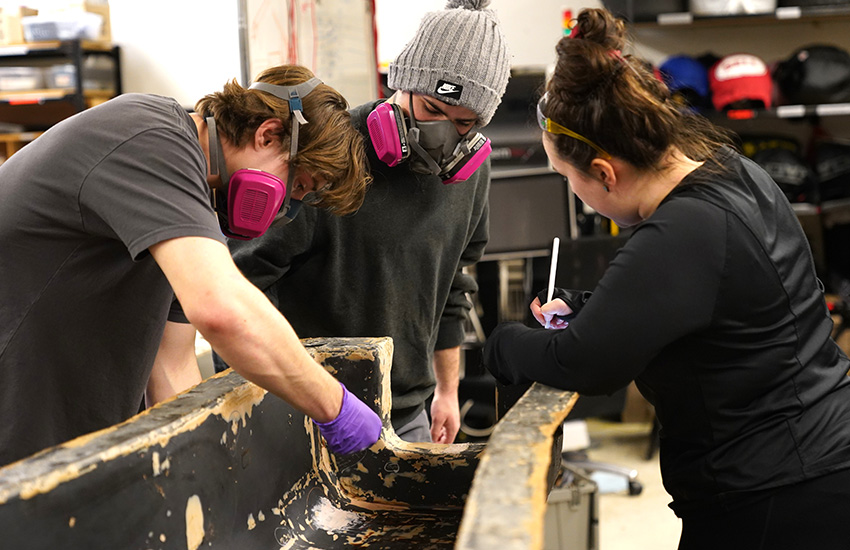
UWFM members do almost all manufacturing and assembly in-house. Here, ME and MSE students prep the monocoque mold of this year’s car before carbon fiber layup. Photo courtesy of UWFM
Clubs expand students’ knowledge of technical skills such as soldering, machining, printed circuit board (PCB) design and computer-aided design (CAD) modeling. Beyond technical skills, students also gain valuable expertise in leadership, communication and collaboration.
UWFM — which designs, builds and races an electric formula-style race car — was Brynestad’s first experience developing a product in a business-like environment. Like other clubs, the team governs itself, with teams that handle sponsorships and public relations.
“From an engineering perspective, Formula offers members the opportunity to see a product through its entire lifecycle — from design, analysis, manufacturing, test, assembly, operation and maintenance,” he says.
As a UWFM member, ME senior Sherveen Mehrvarzan learned about load transfer, helped create a new suspension system and integrated team projects into one vehicle. His contributions as technical director helped the team secure third-place in the 2023 Formula SAE Electric competition. Through his experiences, he says he became a more well-rounded engineer.
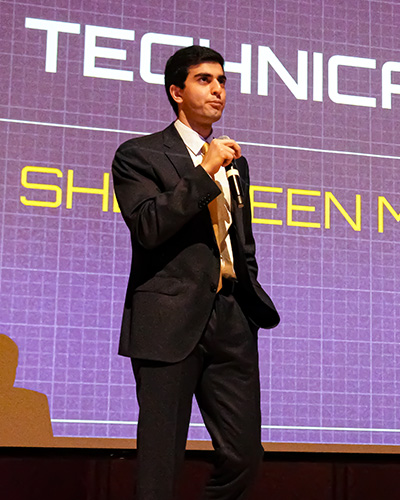
ME senior Sherveen Mehrvarzan. Photo courtesy of UWFM
“Making sure a part successfully fulfills inter-team goals and incorporates well with other parts of the car gave me more insight into integration engineering,” Mehrvarzan says. “The club also provided me with a new perspective on electrical design, specifically how to implement firmware onto different boards on the car and how each system electrically communicates with one another.”
While in UWHPS, which designs and manufactures a submarine to compete in international competitions, Hempstead collaborated with and led team members from other disciplines, and interacted with industry supporters.
“A student club is one of the earliest opportunities to really communicate your ideas to others and understand others’ priorities, which are essential parts of an engineering job,” Hempstead says. “In a leadership role, I learned how to coordinate the efforts of individuals who all have a lot going on in school, life and families.”
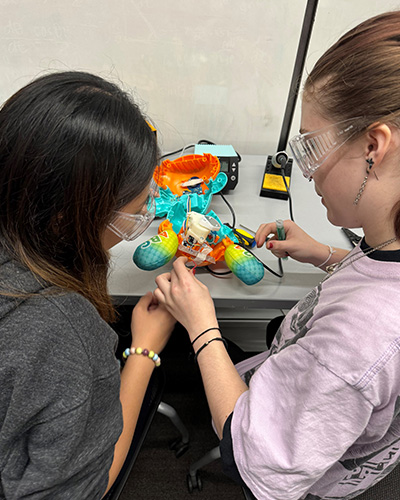
The HuskyADAPT club includes the toy adaptation program, in which students make toys accessible for local children with disabilities. Photo courtesy of HuskyADAPT
Through HuskyADAPT’s toy adaptation program, students learn to deconstruct toys, understand their circuitry and solder in connections to make the toys accessible for local kids with disabilities. For example, instead of pushing a button to activate a toy, a child might move their finger or tilt their head.
“One of the unique aspects of HuskyADAPT is that they learn fundamentals of accessible and inclusive design,” says Kat Steele, the Albert S. Kobayashi Endowed Professor of Mechanical Engineering and ME’s HuskyADAPT faculty adviser. “Training future engineers in these principles is critical to support the design of accessible and inclusive products and environments.”
Mikolyuk’s HuskyADAPT experiences included toy adaptation, building sensory toys for children with autism spectrum disorder and revamping the design team program to develop workshops, build industry relationships, organize community events and more.
“The most important skill I learned was empathy,” Mikolyuk says. “I learned how to ask the right questions and use the right methods to understand a customer’s pain points and motivations, and how to translate those into sensible design requirements and check my work with the customer at every step.”
Set-up for success
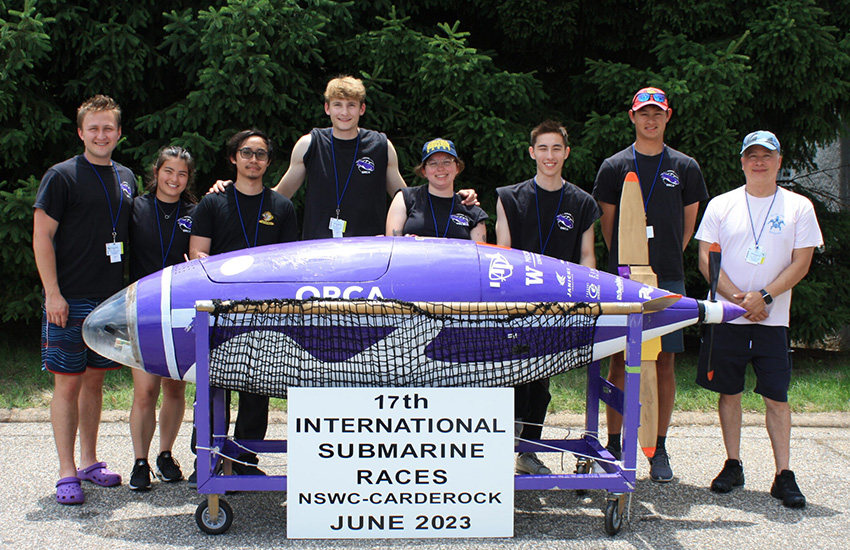
UWHPS members at the 023 International Submarine Races. Photo courtesy of UWHPS
At Chiplytics, Mikolyuk’s responsibilities throughout the product design cycle include concept generation, mechanical design and test engineering, industrial design, technical communication and user feedback gathering.
“My transition from student life to a fast-paced startup environment and a cutting-edge problem space was made so much easier by the fact that we use the same iterative user-centered design process that the HuskyADAPT design teams live and breathe,” he says.
After graduating this spring, Mehrvarzan is gearing up to pursue a master’s degree in mechanical or electrical engineering. He’s applied skills learned in UWFM at internships, including at Tesla’s vehicle engineering team.
“My experience troubleshooting both the mechanical and electrical parts of the Formula car gave me insight on how to approach problems on a larger scale when it comes to production vehicles,” he says. “Also, the rapid pace of Formula Motorsports translated into the work environment at Tesla, and helped me prepare to think on my feet and design at the rate expected of me.”
Hempstead, who’s worked in engineering for 30 years, credits the technical skills and leadership experience gained from UWHPS with helping him successfully interview for his first job and model how to develop “effective and loyal teams built on trust and camaraderie.” Now as someone who helps hire recent graduates, he appreciates when applicants have student club experience.
“There’s a difference between being able to recite why something works and really understanding how it works,” Hempstead says. “I enjoy meeting the team captains or other club leaders who have experienced the higher-level challenges of fielding a team. Those experiences make them very attractive candidates for the innovative companies of today that expect a lot from UW graduates.”
Originally published April 15, 2024